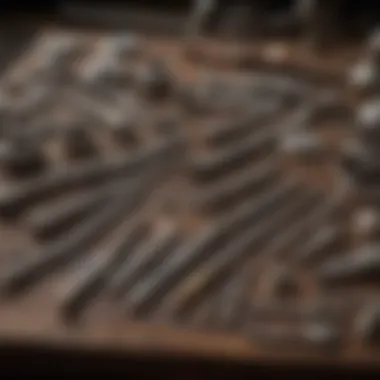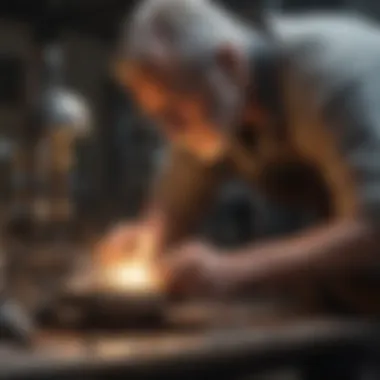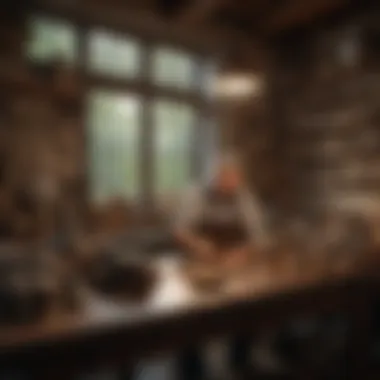Discover the Intricacies of Silversmithing: A Beginner's Comprehensive Guide


Rock and Fossil Identification
Silver and its intricacies mirror the complexity found in rocks and fossils. Before delving into silversmithing, it's crucial to understand the types of rocks and fossils that shape our Earth. By familiarizing yourself with the various characteristics to look for, you can lay the groundwork for your silversmithing journey. Equip yourself with specialized tools for identification, as these will be your allies in deciphering the unique features of each rock and fossil encountered during your craft.
Collecting Tips and Techniques
While exploring the world of silversmithing, collecting becomes an essential aspect. Embrace best practices to ensure the quality of your collections. Discover the art of locating prime collecting sites, where hidden treasures await your exploration. Safely extracting specimens is a skill to be honed, respecting the delicate balance of nature while preserving these precious finds for future creative endeavors.
Preservation and Display
Preservation plays a vital role in silversmithing, just as it does in the world of rocks and fossils. Delving into techniques for preserving these natural marvels ensures their longevity and beauty. Explore proper storage methods to safeguard your collections, allowing them to withstand the test of time. Additionally, immerse yourself in creative display ideas to showcase your silversmithing creations alongside these geological wonders.
Geological Insights
A deeper understanding of geological formations and processes can enrich your silversmithing journey. Explore the historical significance ingrained in rocks and fossils, unraveling the tales engraved in these ancient materials. Discover notable discoveries in the field, drawing inspiration from the scientific and artistic intersections that shape our perception of the Earth's history and evolution.
Introduction to Silversmithing
Silversmithing, a meticulous craft dating back centuries, holds a significant place in the world of artisanal pursuits. In this comprehensive guide tailored for beginners, we delve into the fundamentals of silversmithing, providing aspiring artists with a robust foundation to unlock their creative potential and master the art of working with silver.
Understanding the Art of Silversmithing
History of Silversmithing
Exploring the historical trajectory of silversmithing unveils a rich tapestry of techniques and traditions passed down through generations. The evolution of silverwork reflects societal changes, artistic movements, and technical advancements, offering enthusiasts a deep well of inspiration to draw from in their own creative endeavors. Understanding the historical context not only adds depth to one's practice but also fosters a sense of connection to the lineage of silversmiths who have shaped the craft.
Significance of Silver as a Crafting Material
The inherent qualities of silver as a crafting material make it a preferred choice for artisans seeking durability, malleability, and timeless elegance in their creations. From antiquity to modernity, silver has captivated craftsmen with its lustrous sheen, making it a versatile medium for intricate designs and refined finishes. Exploring the significance of silver in silversmithing amplifies one's appreciation for its unique properties and enduring allure, guiding novices towards informed material choices.
Setting Up Your Workspace
Essential Tools for Silversmithing
Equipping oneself with the essential tools for silversmithing is paramount to executing projects with precision and efficiency. From saws and hammers to mandrels and torches, each tool plays a distinctive role in shaping silver and bringing designs to life. Understanding the functions and maintenance of these tools empowers beginners to navigate the intricacies of silversmithing with confidence and finesse.
Organizing Your Workspace for Efficiency
A well-organized workspace is the hallmark of a productive silversmith, facilitating seamless transitions between tasks and optimizing workflow. By creating designated areas for tools, materials, and workstations, artisans can eliminate clutter and distractions, fostering a conducive environment for creativity and focus. Implementing efficient workspace layouts and storage solutions streamlines the silversmithing process, enabling practitioners to work methodically and achieve professional results.
Materials and Techniques


Types of Silver Alloys
The diversity of silver alloys available to silversmiths offers a spectrum of properties, including varying degrees of hardness, color, and tarnish resistance. Understanding the unique characteristics of sterling silver, fine silver, and alloy blends equips artisans with the knowledge to select the most suitable material for their projects. Exploring the nuances of silver alloys cultivates an appreciation for the material's versatility and adaptability, encouraging experimentation and innovation in design.
Basic Silversmithing Techniques
Mastering fundamental silversmithing techniques forms the cornerstone of artistic development in this craft. From soldering and shaping to polishing and finishing, each technique contributes to the creation of refined silver pieces that exhibit skill and artistry. Practicing basic techniques with dedication and precision hones one's craftsmanship, laying the groundwork for tackling more advanced processes and pushing creative boundaries.
Safety Precautions
Handling Silver Safely
Safe handling of silver involves adhering to best practices to prevent accidents, minimize wastage, and ensure the preservation of materials. By familiarizing oneself with proper storage methods, handling techniques, and maintenance protocols, silversmiths can mitigate risks and maintain a secure working environment. Prioritizing safety not only safeguards valuable resources but also instills a sense of responsibility and professionalism in the practice of silversmithing.
Protecting Yourself from Hazards
Identifying potential hazards in the silversmithing workspace and implementing proactive safety measures are essential steps in safeguarding against injuries and health risks. From ventilation and protective gear to ergonomic considerations, creating a safe work environment is non-negotiable in artisanal pursuits. By prioritizing occupational safety and wellness, artisans can enjoy peace of mind while immersing themselves in the intricate art of silversmithing.
Getting Started with Silversmithing
In the realm of silversmithing, the initial steps hold paramount importance as they lay the groundwork for a journey filled with creativity and skill development. Getting started with silversmithing involves familiarizing oneself with the essential tools of the trade and understanding the basic techniques required to craft stunning silver pieces. Beginners embarking on this path must carefully consider the setup of their workspace to ensure efficiency and safety throughout their silversmithing endeavors.
Practical Projects for Beginners
Creating a Silver Ring
Creating a silver ring serves as an ideal introductory project for beginners entering the world of silversmithing. This project allows novices to grasp fundamental techniques such as shaping, soldering, and finishing. Crafting a silver ring provides a hands-on experience in working with this versatile metal and offers the satisfaction of wearing a self-made piece of jewelry. While forging a silver ring may seem daunting at first, the process of learning to manipulate silver wire and sheet metal can be both challenging and rewarding.
Forging a Silver Bracelet
Forging a silver bracelet introduces beginners to the art of shaping metal into wearable adornments. This project focuses on hammering, bending, and texturing silver to create a unique bracelet design. The process of forging a silver bracelet hones skills in metalwork and design, allowing beginners to explore different techniques and create personalized jewelry pieces. Although forging a silver bracelet requires patience and attention to detail, the end result is a stunning accessory that reflects the maker's creativity and craftsmanship.
Developing Your Design Skills
Drawing Inspiration for Silver Designs
Drawing inspiration for silver designs is a crucial aspect of honing one's creativity in silversmithing. Exploring various sources of inspiration, such as nature, architecture, or personal experiences, can spark innovative design ideas for silver jewelry. Developing a keen eye for detail and aesthetics enables silversmithing enthusiasts to translate their concepts into tangible pieces of art. Drawing inspiration for silver designs fosters originality and imagination, essential qualities for aspiring silversmiths seeking to create distinctive and visually striking jewelry.
Experimenting with Patterns and Textures
Experimenting with patterns and textures expands the design possibilities for silversmiths, allowing them to add depth and intricacy to their creations. By exploring different texturing techniques and integrating various patterns into their designs, artists can elevate the visual appeal of their silver jewelry. Experimenting with patterns and textures encourages silversmiths to push the boundaries of conventional design, fostering innovation and uniqueness in their pieces. This creative exploration enables artisans to develop their signature style and evolve artistically in the world of silversmithing.


Seeking Guidance and Mentorship
Joining Silversmithing Workshops
Joining silversmithing workshops provides beginners with valuable hands-on experience and expert guidance essential for skill development. These workshops offer a supportive environment where individuals can learn traditional and contemporary silversmithing techniques from experienced professionals. Engaging in workshops not only enhances technical skills but also allows for networking with fellow enthusiasts, fostering a sense of community within the silversmithing realm. Joining silversmithing workshops catalyzes learning and growth, propelling individuals towards mastering the art of working with silver.
Connecting with Experienced Silversmiths
Connecting with experienced silversmiths serves as a priceless opportunity for beginners to gain insights and advice from seasoned craftsmen. Establishing mentorship relationships with skilled practitioners in the field enables novices to receive personalized guidance and constructive feedback on their work. Experienced silversmiths can impart knowledge on advanced techniques, design principles, and industry practices, helping beginners navigate their silversmithing journey with wisdom and clarity. Building connections with experienced silversmiths cultivates a culture of learning and mentorship, nurturing the next generation of artisans in the craft of silversmithing.
Mastering Advanced Techniques
Intricate Metalwork
Repoussé and Chasing Techniques
Revered for their intricate nature, Repoussé and Chasing Techniques stand out as pillars within the silversmithing domain. Renowned for their ability to impart intricate designs and textures onto silver surfaces, these techniques require skill, precision, and patience. The distinctive characteristic of Repoussé involves creating a design by hammering the silver from the back, resulting in a raised effect on the front. In contrast, Chasing involves refining and detailing the design from the front using specialized tools.
Filigree and Granulation Methods
Filigree and Granulation Methods contribute significantly to enriching the overall silversmithing process. Filigree entails intricate wirework, creating delicate patterns and designs by soldering thin silver threads together, adding a touch of elegance and sophistication to the final piece. Granulation, on the other hand, involves fusing tiny silver granules onto a surface, forming intricate patterns reminiscent of ancient craftsmanship.
Stone Setting and Engraving
Setting Gemstones in Silver
The art of setting gemstones in silver brings a whole new dimension to silversmithing by incorporating precious stones into the design. This process requires meticulous precision to secure the gemstones firmly while enhancing their beauty. Setting gemstones in silver allows artisans to create luxurious pieces that exude elegance and sophistication, appealing to a discerning clientele.
Adding Personalized Engravings
Personalized engravings infuse a sense of individuality and sentiment into silver creations. By adding personalized engravings, silversmiths can tailor pieces to commemorate special occasions or convey personal messages. This customization adds a personal touch to the jewelry, making it unique and cherished by the wearer.
Experimenting with Patinas
Creating Unique Finishes with Patina Solutions
Experimenting with patinas offers silversmiths a creative avenue to enhance the visual appeal of their creations. By applying patina solutions, artisans can achieve unique finishes that add depth and character to the silver. This technique allows for the creation of aged or oxidized appearances, adding a contemporary twist to traditional silver jewelry.
Enhancing Texture and Depth in Your Pieces
Enhancing texture and depth in silver pieces adds a tactile quality that captivates the senses. By incorporating texture through techniques like hammering, etching, or reticulation, silversmiths can create visually dynamic pieces that interact with light and shadow. This depth adds richness and visual interest to the jewelry, making it truly stand out in the competitive market.


Marketing Your Silver Creations
In the realm of silversmithing, understanding the significance of marketing your silver creations is vital for budding artisans. Marketing not only showcases your creations to a broader audience but also establishes your presence in the industry. Branding your silver pieces is essential for recognition and customer retention, bridging the gap to potential buyers seeking exquisite craftsmanship. By effectively marketing your creations, you can elevate your craft from a passion to a profitable endeavor, gaining visibility and credibility within the silversmithing community.
Building Your Brand
Creating an Online Portfolio
Creating an online portfolio plays a pivotal role in showcasing your silver creations to a global audience. This digital platform serves as a visual gateway for enthusiasts and buyers to explore your work, providing detailed insights into your design aesthetics and craftsmanship. Online portfolios allow for easy updating of your latest collections, enabling you to stay relevant in the ever-evolving silversmithing market. While online portfolios offer convenience and accessibility, they also pose challenges such as maintaining security measures to protect your digital assets.
Crafting a Unique Brand Identity
Crafting a unique brand identity is paramount in setting yourself apart in the competitive silversmithing landscape. Your brand identity encompasses your values, style, and message, resonating with your target audience. A unique brand identity not only fosters brand loyalty but also differentiates your creations from mass-produced silver jewelry. Building a distinctive brand identity involves meticulous strategizing to ensure consistency across all branding elements, including logos, packaging, and marketing materials. However, the process demands constant innovation to prevent your brand from becoming stagnant and easily forgettable.
Social Media Strategies
Engaging with Your Audience
Engaging with your audience through social media platforms is a dynamic approach to connect with potential customers and fellow silversmithing enthusiasts. By cultivating a responsive and interactive online presence, you can build a loyal following that appreciates your craftsmanship and engages with your content. Responding to comments, sharing behind-the-scenes glimpses of your creative process, and seeking feedback from your audience fosters a sense of community and creates a human connection beyond the silver pieces you craft.
Utilizing Visual Platforms for Showcase
Utilizing visual platforms like Instagram and Pinterest offers a visually compelling way to showcase your silver creations to a visually-driven audience. These platforms enable you to curate aesthetically pleasing galleries that highlight the intricate details of your work, attracting potential customers with stunning visuals. Visual platforms also facilitate collaborations with other artists and influencers, expanding your reach and enhancing your online presence. However, maintaining a consistent visual aesthetic while adapting to ever-changing algorithms and trends poses a challenge for silversmiths navigating the competitive social media landscape.
Selling Your Pieces
Exploring Online Marketplaces
Exploring online marketplaces provides silversmiths with a digital platform to reach a broader consumer base beyond their local sphere. Platforms like Etsy, Artfire, and Notonthehighstreet offer global visibility for your silver creations, connecting you with customers seeking unique and handcrafted pieces. Diversifying your sales channels through online marketplaces allows you to tap into different market segments and explore international opportunities. However, navigating through the competition and ensuring your products stand out amidst a sea of offerings require strategic marketing tactics and consistent branding efforts.
Approaching Local Boutiques and Galleries
Approaching local boutiques and galleries offers a more personalized and intimate avenue for selling your silver pieces within your community. Collaborating with boutique owners and curators allows you to showcase your creations in curated settings that cater to niche audiences appreciative of handcrafted jewelry. Establishing partnerships with local establishments enhances your brand credibility and offers a physical touchpoint for customers to experience your pieces firsthand. However, the process of securing partnerships with boutiques and galleries demands effective communication, product presentation, and negotiation skills to forge mutually beneficial relationships.
Conclusion
In the realm of silversmithing, the conclusion is not merely an endpoint but signifies a significant phase in an artisan's journey. It encapsulates a moment of reflection and appreciation for the progress made, igniting the spark for further refinement. Delving deep into this concluding chapter allows aspiring silversmiths to grasp the evolution of their skills and envision the path ahead. It serves as a cornerstone for personal growth and artistic development, urging craftsmen to push boundaries and innovate. The Conclusion section, although seemingly a culmination, actually acts as a launchpad for continuous improvement and exploration in the craft.
Embark on Your Silversmithing Journey
Reflecting on Your Progress
Reflecting on one's progress is a fundamental aspect that holds immense value in the world of silversmithing. It offers a moment of introspection, allowing artisans to celebrate achievements and learn from challenges. By analyzing past works and techniques, silversmiths can identify areas of improvement and set new goals for growth. This reflective practice not only boosts confidence but also enhances creativity by inspiring fresh ideas. It serves as a checkpoint in the journey, enabling craftsmen to pivot and refine their skills to reach new heights.
Continuing to Refine Your Skills
Continuing to refine one's skills is a perpetual quest for excellence in silversmithing. It involves honing existing techniques, experimenting with novel approaches, and seeking further education in the craft. The relentless pursuit of refinement cultivates mastery and distinguishes exceptional artisans from the rest. By dedicating time to practice, explore, and learn, silversmiths can elevate their work to unparalleled levels of sophistication. This ongoing process of skill enhancement not only sharpens craftsmanship but also fosters innovation, pushing the boundaries of what is possible in the realm of silversmithing.







